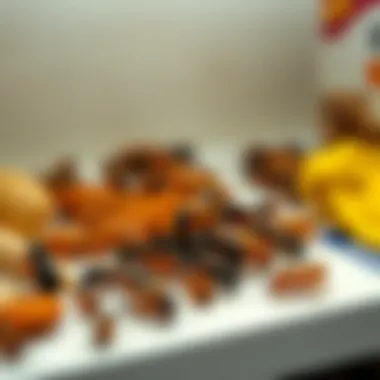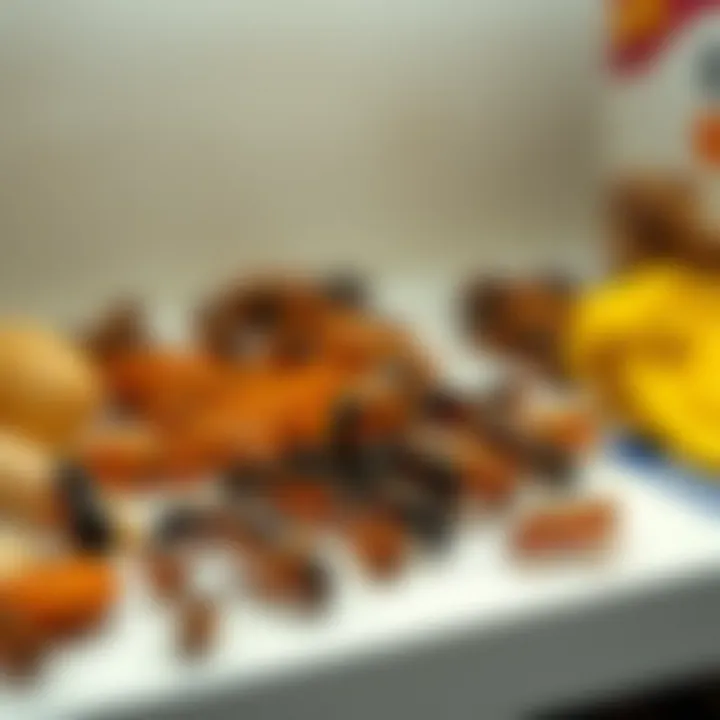Effective Strategies to Combat Pantry Pest Infestations


Intro
Keeping a pantry free from pests is more than just a matter of convenience; it’s about health and safety. Many homeowners find themselves in a battle against unwanted critters that have taken up residence among their food supplies. This may seem like a common kitchen annoyance, but the reality is these pests can lead to significant food waste and, in some cases, health risks. To tackle this issue effectively, this guide breaks down the essential strategies for identifying, preventing, and treating insect infestations within your food pantry. Let’s roll up our sleeves and explore the steps you can take to ensure your pantry remains a safe haven for your groceries.
Pest Identification
Identifying the pests lurking in your pantry is the first crucial step in the fight against infestation. Understanding what you’re up against puts you in a better position to deal with them efficiently.
Common Pests in Food Pantries
Several typical pests are notorious for invading pantries. Familiarize yourself with these invaders:
- Pantry Moths (Indian Meal Moth): These small, grayish-brown moths, often found flitting around your food storage, are a major headache. Their larvae can be found in grains and dried foods.
- Weevils: These beetles can drill into grains, nuts, and even dried fruits. They are often mistaken for grains when you see them.
- Cockroaches: While often associated with dirty spaces, cockroaches can sneak into your pantry and contaminate food with droppings and saliva.
- Ants: When food is left uncovered or spills occur, ants can form long lines to access pantry goodies, quickly overwhelming the area.
Signs of Infestation
Look out for the following signs that may indicate an infestation:
- Presence of small holes or webbing in food packages.
- Unusual amounts of frass (excrement) near food items.
- Visible insects or larvae crawling in or around pantry goods.
"The first step in pest control is knowing what pests you have to control."
Recognizing these signs early can help in taking swift action before the problem escalates.
Prevention Strategies
Once you've tackled pest identification, implementing robust prevention strategies is key in keeping your pantry pest-free.
Home Maintenance Tips
Regular maintenance of your pantry is essential. Consider these simple yet effective practices:
- Seal Food Properly: Invest in airtight containers for dry goods. This not only keeps pests out but also maintains the freshness of your food.
- Clean Regularly: A tidy pantry is less attractive to pests. Wipe down shelves and clean up spills immediately to eliminate potential food sources.
- Inspect New Purchases: Before bringing items home from the store, check for signs of infestation especially in bulk products.
Natural Deterrents and Barriers
Using natural deterrents can help keep pests at bay.
- Bay Leaves: Placing bay leaves in your food containers may deter many pantry pests due to their strong aroma.
- Essential Oils: Some essential oils, such as peppermint and lavender, act as effective insect repellents. Mixing a few drops with water can create a spray that keeps pests away.
Treatment Options
If you discover an infestation, timely treatment is crucial.
Chemical vs. Natural Treatments
There’s a plethora of options when it comes to treatment, ranging from chemical solutions to more gentle natural remedies. Here’s a quick rundown:
- Chemical Treatments: While effective, these should be used with caution. Follow the instructions carefully to avoid contaminating food items.
- Natural Treatments: Options like diatomaceous earth can be sprinkled in affected areas. It’s safe for food but deadly to many insects by damaging their exoskeletons.
Step-by-Step Guides for DIY Treatments
If you’re inclined to take things into your own hands, consider these DIY approaches:
- Diatomaceous Earth Application:
- Cedarwood:
- Regular Monitoring:
- Find food-grade diatomaceous earth.
- Lightly dust shelves and areas where you’ve noticed pests, including any cracks where they might be hiding.
- Place cedar blocks or shavings in the pantry to repel bugs. Not only does it smell pleasant, but it also keeps pests away.
- Make it a habit to check your pantry regularly as part of your home maintenance, so if pests do appear, you can act quickly.
Understanding Pantry Pests
Understanding pantry pests is key to securing your food storage. Ignoring these unwelcome guests can turn a cozy kitchen into a nightmare, with contaminated grains and uneaten food. It's not just about the ick-factor; these pests can spoil food and lead to health problems. Identifying pests early helps put a stop to their invasion, saving money and protecting your family's health.
Pests don’t just appear out of nowhere; they have specific habits, life cycles, and behaviors. Each kind of bug has its quirks, from the way they breed to the types of food they target. Grasping this knowledge doesn’t just raise your awareness—it arms you with strategies to combat and prevent infestations effectively.
Common Types of Pantry Bugs
Pantry Moths
Pantry moths, especially the Indian meal moth, are among the most recognized pantry nuisances. Their small, fuzzy bodies flutter about and can breed quickly, leading to a severe infestation in no time. A characteristic feature of pantry moths is their propensity to weave silk webbing among stored food, serving as both a protective cocoon for their larvae and a signal of their presence. This can result in significant losses, as they often infest whole batches of grains, spices, and various dried goods.
While they might seem harmless, their presence means contamination of food supplies. Additionally, the larvae can consume a wide range of pantry staples. Therefore, recognizing and addressing an infestation of pantry moths is crucial for maintaining a healthy environment.
Weevils
Weevils, often found in grains and flour, are another major inhabitant of the pantry. Their distinctive snouts set them apart. Unlike the pantry moth, weevils silently invade your foods, often unnoticed until the damage is done. Their eggs are laid directly within the food, making it quite a challenge to catch them in time.
One critical aspect is identifying weevil-infested items. They leave behind small holes in packaging and leftover shells. Their life cycle is stealthy, and it’s easier to prevent an infestation than to eradicate one. A single female can lay dozens of eggs in a single item, reinforcing the need for vigilance in your pantry.
Beetles
Various beetles can also be pantry intruders, including the confused flour beetle and the red flour beetle. These insects thrive in dry, stored food and can be a major headache for householders. A notable feature of the beetle is its hard outer shell, which is resilient against many treatments, making them tough adversaries.
Beetles are usually easy to spot due to the remnants they leave behind, such as small frass (insect droppings) in the food. This not only indicates their presence but also warns of potential contamination. Thus, their identification is crucial in preventing larger infestations and keeping your pantry reports clean.
Life Cycle and Behavior of Pantry Insects
Egg Stage
The egg stage is where every infestation begins, and it often goes unnoticed. Female pests lay their eggs in or around food, where conditions are optimal for hatching. Eggs can be incredibly tiny and blend seamlessly into the food, making them hard to see. Understanding this stage is essential; it highlights how crucial it is to check all food items closely.
The quicker an infestation can be detected at this stage, the easier it is to manage. This stage emphasizes the importance of regular inspection and storage practices, keeping food containers clean and well-sealed.
Larval Stage
Once eggs hatch, they progress into the larval stage, creating a more significant problem. The larvae devour food, sometimes causing noticeable damage. This stage can last from a few days to several weeks, depending on environmental conditions. Keeping track of this phase is crucial as it marks the time when pests are most destructive, metabolizing calmly through valuable pantry staples.
Additionally, larvae can create webs and messes in food items, making it even more apparent that action must be taken. It is during this phase that many householders realize they have a problem, leading to increased scrutiny of their pantry practices.
Adult Stage


The adult stage is when insects become visible, and their primary goal is reproduction. Adult insects, whether moths, weevils, or beetles, emerge ready to continue their cycle. Their presence signifies that the initial infestation has reached significant levels, warranting immediate action.
Here, knowledge of their habits comes into play. Adults often migrate to new food sources to lay eggs, increasing the likelihood of spreading an infestation throughout other pantry items. Recognizing their activity and understanding how fast they can reproduce often dictates whether you might require pest control assistance or if you can handle it yourself.
Identifying an Infestation
Recognizing an insect invasion in your food pantry is a crucial aspect of maintaining food safety and integrity. Knowing the signs that indicate the presence of these unwelcome guests can help you tackle the issue before it spirals out of control. Furthermore, addressing an infestation early can save you from costly damage, prevent waste, and ensure that your food remains uncontaminated. Not only does proper identification facilitate timely interventions, but it also allows you to arm yourself with the right strategies tailored to the specific pests at hand.
Signs of Bug Presence
Webbing
One of the standout indicators of a pantry pest infestation is webbing. Pantry moths, in particular, are known to create these silk-like structures in hidden corners, around food containers, and in your grains. This webbing acts as their home base, providing them a concealed environment for laying eggs and feeding. Its presence is a clear signal that action is necessary.
- Key Characteristic: Webbing is often sticky and can trap dust and debris, making it visibly unappealing and a health concern.
- Beneficial Aspects: Noticing webbing can lead you to the source of the infestation quicker than considering other signs.
- Unique Features: The webs can build up quickly, and if left untreated, they contribute to further pest proliferation, resulting in more severe infestations. Be vigilant and act swiftly to curtail this issue.
Droppings
The presence of droppings is another serious sign that should not be overlooked. These tiny remnants can vary in size and appearance based on the pest, but they often resemble small dark grains or pellets. Pantry bugs like weevils and beetles leave behind droppings that not only signal their presence but also indicate the degree of infestation.
- Key Characteristic: The droppings often look like miniature grains or seeds, presenting a clear visual indicator within stored grains or flour.
- Beneficial Aspects: Identifying droppings quickly limits your exposure to contaminated food.
- Unique Features: While some may dismiss droppings as mere mess, they unequivocally point to an established population. Don't ignore it, as it can increase the urgency to take corrective measures.
Visible Bugs
Perhaps the most glaring indication of an infestation is the sight of visible bugs. Many pests in food pantries, including moths and beetles, take refuge in your food. Spotting them scurrying about can be quite alarming, but it’s also an opportunity to take immediate action.
- Key Characteristic: Visible bugs vary in shape and size, and catching sight of them can often raise immediate alarm bells.
- Beneficial Aspects: Immediate identification of visible bugs means swift evaluation and remediation of the problem. Recognizing them can guide you to their nests or food sources quickly.
- Unique Features: The sooner you identify these insects at the first sight, the easier it can be to prevent the infestation from escalating, ensuring a cleaner pantry.
Tools for Inspection
Flashlight
A flashlight is an invaluable tool when inspecting your pantry. The ability to shed light into dark corners or behind your pantry products enables you to find potential nests or hidden bugs.
- Key Characteristic: The portability and brightness of modern flashlights allow for easy maneuverability and inspection without hassle.
- Beneficial Aspects: It’s particularly useful in checking tight spots where bugs may hide, making it an essential in your pest-control toolkit.
- Unique Features: Some LED flashlights also come with features, like adjustable beams, which help in focusing precise light on areas of concern.
Magnifying Glass
A magnifying glass aids in closely examining any items that seem suspicious. Sometimes, the signs of infestation can be subtle without a closer look.
- Key Characteristic: This tool brings even the tiniest bugs into view, offering clarity on exactly what you are dealing with.
- Beneficial Aspects: Being able to assess droppings or webbing in detail can lead to more effective pest identification and elimination methods.
- Unique Features: Some magnifying glasses feature built-in LED lights, adding additional illumination for thorough inspections.
Storage Bin Examination
Lastly, storage bin examination is critical when investigating bug presence in your pantry. Going through every bin ensures that you catch any infestation before spreading.
- Key Characteristic: Solid storage bins can prevent access to food, though if they themselves are compromised, examination is key.
- Beneficial Aspects: Inspecting the contents also allows you to assess the condition of your food and remove any with signs of pest activity.
- Unique Features: Stackable bins often offer storage efficiency, but they require periodic checks to monitor for signs of rodents or insects.
Ultimately, identifying an infestation in your pantry is about vigilance and mindfulness. Each sign, tool, and approach lays a foundation for effective pest management, ensuring your food remains uncontaminated and safe for you and your family.
"An ounce of prevention is worth a pound of cure"
Preventive Measures
Taking preventive measures against pests in your food pantry is crucial for maintaining a healthy home. Bugs, such as pantry moths and weevils, can cause significant damage to food items if left unchecked. Understanding the importance of proactive strategies helps in not only keeping the pests at bay but also preserving the quality of food. A well-organized pantry acts as a first line of defense, helping to catch signs of infestation early. With careful consideration of your pantry habits, you can effectively reduce the chances of an outbreak.
Best Practices for Pantry Organization
Sealing Containers
Sealing containers properly is a fundamental step in organizing your pantry. This practice greatly limits bugs' access to your food. Airtight containers create an environment where pests can’t infiltrate and breed, as they are insulated from outside air and moisture. Choosing durable containers made from glass or heavy plastic with secure lids is a great option. Not only do they keep food fresh, but they also prevent any unpleasant surprises when you reach for a snack.
- Key Characteristics: Airtight seals, durability
- Benefits: Prevent bug entry, keep food fresher longer
- Disadvantages: Higher initial cost compared to regular bags or boxes
Regular Cleaning Routines
Implementing a routine for regular cleaning can be a game-changer in pest management. This not only includes wiping shelves and vacuuming corners but also checking for expired items and disposing of them properly. A clean pantry minimizes crumbs and spills, which attract unwanted visitors. Having a scheduled cleaning routine ensures that pantry items are rotated, and potential infestations do not go unnoticed for long periods.
- Key Characteristics: Systematic cleaning schedule
- Benefits: Reduces attractants for pests, promotes food safety
- Disadvantages: Time-consuming, may require effort to maintain consistency
Using Airtight Storage
Using airtight storage is another powerful remedy to combat pests in your pantry. Consider investing in containers that are specifically designed to be impermeable to moisture and air. These options are typically made from thick plastic or glass. This feature not only serves the purpose of preventing pests but also helps in keeping ingredients like flour, rice, or cereals fresher.
- Key Characteristics: Strong, tightly-fitting lids
- Benefits: Dual purpose of keeping out pests and maintaining ingredient quality
- Disadvantages: Can be bulky and take up space,
Environmental Control
Temperature Regulation
Controlling the temperature in your pantry significantly influences pest activity. Bugs thrive in warm environments, so regulating the temperature can make a considerable difference. Keeping your pantry at a cooler temperature will deter insects from establishing a breeding ground. It’s advisable to store items, particularly dry goods related to baking, in parts of the house where temperature is more stable.
- Key Characteristics: Cooler environments discourage pests
- Benefits: Reduces the likelihood of pest reproduction
- Disadvantages: Requires monitoring to maintain consistent temperatures
Humidity Control
Humidity control also plays a vital role in keeping pantry bugs at bay. Many pantry pests flourish in humid conditions, leading to moldy food and infestations. Using dehumidifiers or ensuring proper air circulation can help maintain a drier environment. Regularly checking the humidity level will help you adjust accordingly and keep your pantry pest-free.
- Key Characteristics: Drier conditions reduce bug presence
- Benefits: Promotes food safety, prevents spoilage
- Disadvantages: Extra equipment may be needed, such as dehumidifiers
By following these best practices and environmental controls, you can proactively manage your pantry and maintain a bug-free haven for your food.
Natural Remedies for Infestation
Natural remedies hold a significant role when tackling pest infestations in food pantries. Not only are they often more gentle on the environment, but they also provide steps that homeowners can implement without reaching for harsh chemicals. Using these remedies, one can create a safer food storage area while still being effective against pesky insects. Relying on the power of nature can also help mitigate the chemical residues that might linger on food products, which is particularly beneficial for families focused on organic lifestyles or those with children.
Herbal Solutions
Bay Leaves
Bay leaves have been known for centuries to keep critters at bay, quite literally. While they may enhance the flavor of food, these leaves can also discourage pantry pests like moths and weevils. The specific aspect of bay leaves is their inherent bitterness. Insects seem to find them unpalatable, prompting them to steer clear of the areas where bay leaves are present.
Key Characteristic: Bay leaves’ strong aroma plays a central role here—it’s not just about taste but scent as well. When placed in containers or around shelves, their fragrance can create an unwelcome atmosphere for certain bugs.
Advantages: The advantages of using bay leaves in this context are myriad—they’re simple to use, non-toxic, and add no harmful chemicals to your pantry. If you keep a few bay leaves in your flour or rice canisters, this could potentially keep the weevils at bay.


Disadvantages: One downside, however, is that their effectiveness may not last indefinitely. You might need to replace them periodically, as their scent does diminish over time.
Diatomaceous Earth
Diatomaceous earth often crops up in discussions of natural bug treatments. It’s made from fossilized algae and works effectively against a range of bugs by affecting their exoskeleton. When pests come into contact with this powder, it dehydrates them, ultimately leading to their demise.
Key Characteristic: The key thing about diatomaceous earth is that it’s entirely natural, which makes it a popular choice among folks who prefer greener alternatives. And just to be clear, this isn’t a chemical concoction—it's simply finely ground material that’s safe for humans and pets, as long as it’s food-grade.
Advantages: The unique feature of this substance is its mechanical action rather than a chemical one, giving it a long-lasting effect as it remains in the pantry. This means that any bug that crosses its path can be exterminated without the need for constant reapplication.
Disadvantages: One must exercise caution when using diatomaceous earth since inhaling it can be irritating. Therefore, wearing a mask during application is recommended, especially for those with existing respiratory issues.
Essential Oils as Deterrents
Essential oils have also become popular among those looking for natural bug deterrents. They not only smell delightful to humans but tend to send bugs scampering away.
Peppermint Oil
Peppermint oil is often touted as a powerful repellent. The strong, invigorating fragrance is favored by many for its ability to mask scents that attract pests.
Key Characteristic: The menthol in peppermint is particularly effective at disrupting the olfactory senses of certain critters, creating an inhospitable environment for them.
Advantages: What makes using peppermint oil appealing is its dual role; while it acts as a pest deterrent, it can also leave your pantry smelling fresh. Users can mix it with a carrier oil and spray it in suspected infested areas.
Disadvantages: On the downside, peppermint oil can sometimes require frequent reapplication, especially in a pantry where food odors can dilute its effectiveness.
Lavender Oil
Lavender oil brings a touch of tranquility while simultaneously keeping pests at bay. Known for its calming properties, this essential oil is also a formidable opponent against pesky moths and beetles.
Key Characteristic: Lavender's soothing scent can confuse bugs, rendering them less likely to loiter in your pantry.
Advantages: One of its significant benefits is its versatility; it can function as both a repellent and a pleasant fragrance. Placing cotton balls soaked in lavender oil in your pantry can create a more inviting atmosphere for you while discouraging unwelcome guests.
Disadvantages: However, lavender oil’s efficacy might fade over time, necessitating a regular maintenance schedule to keep the scent potent.
In summary, when looking to eliminate bugs from your food pantry, natural remedies provide a holistic approach. They empower homeowners to create effective pest management strategies without compromising their health or the environment.
Chemical Treatments
In the ongoing battle against pantry pests, chemical treatments often come into play as a significant line of defense. While natural and preventive methods lay a solid groundwork for pest management, chemical solutions can be indispensable when infestations take a foothold. This section delves into commercial pest control products, focusing on insecticides and pest traps, while emphasizing the safety measures necessary during their application.
Commercial Pest Control Products
Insecticides
Insecticides are chemical substances designed specifically to eliminate pest populations. These products provide a direct approach to dealing with unwelcome pantry invaders, making them a often-preferred option for homeowners and pest control professionals alike. A distinctive characteristic of insecticides is their targeted operation—many are formulated to disrupt critical biological processes in pests, effectively controlling their life cycles.
However, users must exercise caution. One notable advantage of using insecticides is their quick effectiveness; many products can show results within hours. This speed can be a lifesaver when dealing with a significant infestation.
Nevertheless, insecticides come with potential drawbacks. They may pose risks to individuals in the home, particularly if not used according to the manufacturer’s instructions. Additionally, some pests may develop resistance over time, diminishing the effectiveness of certain insecticides. Homeowners should always read labels carefully and consider integrating insecticides with other pest management strategies for the best results.
Pest Traps
Pest traps represent a different approach, capitalizing on the behavioral patterns of pantry pests. These traps act as physical barriers, capturing any bugs that venture too close. A key characteristic of pest traps is their non-invasive nature; they can often be safely used around food without the risk of chemical exposure.
One of the major benefits of using pest traps is their ease of use. Simply place them in areas of known pest activity and let them do the work. Not only do they provide immediate feedback on pest activity, they can also help reduce pest populations without the use of harsh chemicals.
On the flip side, while effective for low-level infestations, pest traps may not suffice for larger problems. Additionally, some might find that they require regular monitoring and maintenance to ensure they remain effective. Ultimately, combining these traps with other pest control strategies can enhance their effectiveness.
Safety Measures During Chemical Application
Ventilation
Proper ventilation is crucial when applying any chemical treatments in your pantry. This practice ensures that harmful fumes dissipate, reducing exposure risks for anyone in the home. Furthermore, adequate ventilation helps maintain indoor air quality, preventing the buildup of potentially toxic substances.
A key benefit of ensuring good airflow is that it allows you to apply chemical treatments with confidence, knowing you are minimizing health risks for yourself and your family. It is wise to keep windows open and exhaust fans running while applying treatments. However, one should always check weather conditions to avoid indoor chemical exposure if the outdoors is particularly windy or stormy.
Protective Gear
Using protective gear is just as important as proper ventilation. This gear typically includes gloves, masks, and goggles, all designed to shield you from chemical exposure during application. The main characteristic of protective gear is its ability to create a barrier between your skin and airborne particles, enhancing safety.
The advantages of employing protective gear cannot be overstated. By donning this equipment, you significantly lower the risk of skin irritation, respiratory issues, and other health problems associated with chemical exposure. However, it's vital to refer to the guidelines specific to each product when determining what equipment is necessary for use.
Thorough Cleaning Techniques
In the battle against bugs in your food pantry, thorough cleaning techniques play a pivotal role. These practices are fundamental in ensuring any lurking pests have nowhere to hide and that your pantry stays free of unwanted guests. Think of cleaning as the first line of defense. Regular and meticulous cleaning helps identify potential infestations at their earliest stage, effectively minimizing their impact. Not only does it rid your pantry of pests, but it also helps eliminate food spills, crumbs, and residues that may attract these bugs in the first place.
Emptying the Pantry
Inventory Management
When it comes to inventory management, effective organization is key for tackling pantry pests. This process involves categorizing and keeping track of your food items, which can help identify old or infested products promptly. The main characteristic of this approach is its proactive nature—rather than waiting for an issue to arise, you take charge by monitoring what you have on hand.
By routinely checking expiry dates and using a first-in-first-out (FIFO) system, you ensure no food is left untouched for too long. This technique proves to be beneficial as it not only reduces waste but enhances food safety. A unique feature of inventory management is its ability to streamline cooking and meal planning, but it does come with a downside: it requires consistency and commitment. Staying organized can be a hassle for some, especially amidst a busy lifestyle.
Disposal of Contaminated Items
The disposal of contaminated items is equally vital when addressing pest issues in your pantry. This aspect entails recognizing and safely discarding foods that show signs of infestation or spoilage. The key characteristic here is decisiveness—once you determine something is compromised, it is crucial to act swiftly. This method stands out as a popular choice because it directly eliminates the source of the problem, which can significantly reduce the chances of pests reinfesting your pantry.
A unique feature of this practice is that it fosters a cleaner living environment and helps maintain the integrity of untouched food items. Nevertheless, there is an inherent challenge: parting with food can be difficult, especially if it seems usable. However, weighing the risks of contamination versus the loss of food is a critical consideration that warrants urgency in disposal.
Deep Cleaning Solutions
Vinegar Solutions
Utilizing vinegar solutions in deep cleaning is a great strategy for keeping pantry pests at bay. Vinegar's acetic acid content is known to be a natural bug repellent, which makes it an excellent choice for creating a safe environment in your pantry. The standout characteristic of vinegar solutions is their versatility and effectiveness; they can penetrate bacteria and help neutralize odors that may attract pests.
This cleaning method is beneficial because vinegar is non-toxic and widely available, allowing you to maintain a pest-free pantry without using harsh chemicals. The unique aspect of using vinegar is its dual functionality as both cleanser and repellent, providing a comprehensive solution to the problem. However, some individuals may find the smell off-putting, and vinegar does not tackle all types of pests equally, which is a consideration worth noting.
Soap and Water Mixtures
Soap and water mixtures also serve as an effective deep cleaning method. This combination not only cleans surfaces but can eradicate a variety of pests, particularly when their nests are disrupted. The key trait of soap and water is its simplicity, making it an accessible choice for nearly everyone.
Using a diluted soap solution can help remove dirt and residue while acting as a physical barrier against pests. The advantage of this mixture lies in its safety for food areas, ensuring your chemical free environment is maintained. However, one must keep in mind that not all soap types are created equal; some may leave behind residues or scents that aren't ideal for food storage areas.


When maintaining a clean pantry, combined strategies yield the best results. Don't hesitate to mix different cleaning solutions as needed to fit your specific environment and pest issues.
Long-Term Management Strategies
Establishing long-term management strategies within your pantry is essential for maintaining a pest-free environment. These strategies are not just temporary fixes; they help ensure that your food storage remains safe and healthy over time. By focusing on both monitoring and maintenance, homeowners can nip potential infestations in the bud before they become severe problems.
Incorporating regular inspections and scheduled cleaning routines is crucial. It’s like keeping a pulse on your pantry’s condition. The benefits are significant: knowing early on when pests invade could save homeowners time and money, particularly as infestations can escalate quickly. With a proactive approach, one can prevent the spread of bugs and ensure food safety.
Monitoring Techniques
Regular Inspections
The key aspect of regular inspections is vigilance. These inspections facilitate early detection of pantry pests and can greatly influence the effectiveness of your pest management plan. Checking for signs of bug activity, such as webbing or droppings, should become a common routine. This practice is particularly beneficial because it allows homeowners to take action right away, minimizing the chances of a larger infestation.
A unique feature of conducting regular inspections is the ability to become familiar with your pantry's layout and contents. When you regularly scrutinize your food items, you’ll know where to look for potential problems. A downside, however, may be the time it takes to conduct these thorough checks; they might not fit easily into a busy schedule. The effort, nonetheless, often pays off.
Pest Monitoring Tools
Utilizing pest monitoring tools can play a critical role in keeping track of the pantry's condition. These tools range from trap kits designed to catch pests to sticky boards that help identify what types of bugs are present. Their practical application allows homeowners to be more proactive in their approach.
One of the standout characteristics of these tools is their simplicity. They require minimal setup and can be placed discreetly in your pantry. However, while these tools can offer insight into pest activity, they might not always provide a comprehensive solution. Homeowners may find themselves relying on additional methods to fully resolve pest issues.
Building a Maintenance Schedule
Cleaning Frequency
When it comes to cleaning frequency, setting a defined schedule is essential. Regular cleaning plays a significant role in preventive measures against bugs as it eliminates potential food sources for pests. When you set a consistent cleaning timetable, you foster a healthier environment, not just for yourself but also for the food items you store.
This strategy is attractive because it helps in maintaining a generally organized pantry. If everything has a place, it’s less likely for spills or crumbs to attract unwanted guests. The downside is that time constraints may make it challenging to stick to this schedule, but even a modified routine can yield positive results.
Restocking Protocols
Establishing clear restocking protocols is a key component of maintaining a pest-free pantry. This involves careful consideration of how and when items are added back into storage after use or purchase. When you restock items, it's crucial to check packaging for any signs of damage or infestation.
The unique feature of these protocols is that they prompt awareness about what's coming into your pantry. As new products are introduced, this practice ensures that pests are less likely to be inadvertently incorporated into your food supply. On the flip side, such measures require diligence and consistency; forgetting to check an item can lead to issues down the line.
Engaging Professional Help
In some situations, DIY strategies may not cut it when it comes to pest control in your pantry. This is where professional help becomes indispensible. Engaging professionals can not only save you time but also ensure a more thorough eradication of pests that the average homeowner might miss. Pest control experts have specialized knowledge and resources at their disposal. This section outlines why seeking professional assistance is a prudent route in handling pantry pests.
When to Call an Exterminator
Severe Infestations
When you notice a full-blown infestation, it’s time to take a step back and consider calling in an exterminator. A severe infestation is not just annoying; it can lead to substantial food spoilage and potential health risks, as pests carry various diseases. One key characteristic of severe infestations is the overwhelming visual presence of pests like moths or beetles. Seeing them scurry about indicates a situation that is possibly beyond personal control.
The advantage of addressing severe infestations through professional services is clear. Exterminators utilize methods that are effective and safe for your environment, which is crucial when food is involved. One unique feature of dealing with severe infestations is the treatment speed. Exterminators can often handle widespread infestations in a much shorter timeframe than typical home remedies.
On the flip side, hiring an exterminator can be a bit costly. However, given the potential loss of food and the health risks involved, the expense may prove worthwhile.
Continuous Reoccurrence
Another critical point where professional help may be necessary is in the face of continuous reoccurrence. If you find pests return despite your best preventative measures, it’s a signal that something more systemic is at play. Continuous reoccurrence usually points to issues such as unnoticed nesting or food sources you didn’t properly clean.
This is a beneficial choice when considering the aspects of long-term pest control. Professionals often provide more comprehensive solutions that tackle both current infestations and their underlying causes. One unique feature is their ability to provide insights on why infestations keep coming back, which often involves inspections that the average homeowner may overlook.
The downside to continuous pest issues lies in the recurring costs and the need for consistent follow-ups. Yet, it is more favorable to invest in a robust solution than to continue dealing with the headache of recurring pests.
What to Expect from Professional Services
When you finally decide it’s time to call in the experts, it helps to know what the process looks like. Understanding how professional services operate can ease any worries you have about the unknown.
Initial Inspection
One of the first steps in utilizing professional pest control services is the initial inspection. This crucial phase helps the exterminator assess the scale of the infestation and identify the types of pests involved. A key characteristic of initial inspections is their detailed examination of not just the visible clutter but also potential hiding spots for pests.
This is a beneficial phase because it establishes a comprehensive understanding of the problem, leading to a tailored treatment plan that efficiently targets the pest issue. One unique feature of this step is that it often includes identifying contributing factors, such as poor storage practices or entry points that your pantry might have.
The advantage of having a thorough initial inspection is that it provides clarity, eliminating guesswork in treatment strategies. The downside, however, might involve initial costs before you commit to the full treatment plan.
Treatment Plans
Once the inspection is complete, you’ll be presented with a treatment plan. This is where the rubber meets the road. The treatment plan lays out the steps the exterminator will take, including any chemicals or methods they plan to use. One key characteristic of effective treatment plans is their tailored approach—adapted to your specific situation based on the initial inspection.
This step provides a structured timeline and methodical execution, which is often more efficient than home remedies that might be hit or miss. A unique feature of these plans is the post-treatment follow-up, which assesses the effectiveness of the intervention and ensures pests remain absent.
The potential disadvantage lies in the reliance on treatments that may not be suitable for everyone, especially sensitive families or pets. However, many professionals are moving towards more eco-friendly options, balancing efficacy and safety, making this an evolving industry to consider.
Educational Resources
The significance of educational resources in managing pantry pests cannot be overstated. They serve as guiding lights for individuals looking to eliminate bugs and maintain a safe environment for food storage. By tapping into these resources, homeowners can derive valuable insights about pest behavior, prevention strategies, and treatment options. This knowledge can make the difference between a one-off pest problem and a long-term infestation.
The shared experiences and expert knowledge available through various mediums equip the audience with practical information to tackle the unseen battles against pests. Be it a dusty old manual or a modern comprehensive guide, the goal remains the same: to keep pantry goods free from contamination and health hazards.
Books and Guides on Pest Management
Comprehensive Pest Control Manuals
Comprehensive pest control manuals are a treasure trove of information for anyone dealing with pantry pests. These manuals often cover an extensive array of topics—from insect identification to advanced extermination techniques. One of their key characteristics is providing detailed illustrations and clear descriptions, making it easier for readers to identify pests accurately.
What sets these manuals apart is their focus on both prevention and corrective measures, making them a beneficial choice for this article. Homeowners don’t just learn how to eliminate bugs; they gain knowledge about long-term prevention strategies as well. However, the sheer volume of information can sometimes overwhelm readers, especially those new to pest management.
DIY Pest Management Texts
On the other hand, DIY pest management texts appeal to the independent spirit that many homeowners possess. These texts simplify pest control into actionable steps that anyone can follow. The key feature of a DIY approach is its cost-effectiveness, allowing homeowners to use ordinary household items as pest deterrents.
This makes DIY texts a popular choice, especially among those looking to avoid expensive contract services. However, while these guides encourage do-it-yourself solutions, they may lack the comprehensive scope found in professional manuals. Homeowners must remain cautious, as overlooking critical steps could lead to more significant issues down the line.
Online Platforms and Communities
Forums for Sharing Advice
Forums have become invaluable for sharing advice and experiences regarding pantry pest issues. These online platforms allow members to discuss their personal experiences, ask questions, and offer solutions. A key characteristic of these forums is the community support, where fellow members rally to help each other.
This peer-to-peer assistance can be incredibly beneficial—it not only provides practical tips but also leads to a sense of camaraderie. Yet, one must be mindful that the advice is informal and might not always stem from expert opinions. Therefore, verifying information before implementing it is essential to avoid ineffective or harmful practices.
Educational Websites
Educational websites offer a wealth of organized information on pest management, ranging from articles and guides to infographics and video tutorials. A standout feature of these resources is their accessibility; users can retrieve information at their convenience without sifting through physical books or waiting for responses in forums.
These sites are often created by professionals, making them a reliable source for accurate information tailored to common queries. However, the downside is that some sites may bombard viewers with advertisements, making navigation cumbersome. Finding straightforward, ad-free resources can sometimes be a chore, but the treasure trove of knowledge they provide is often worth the effort.



